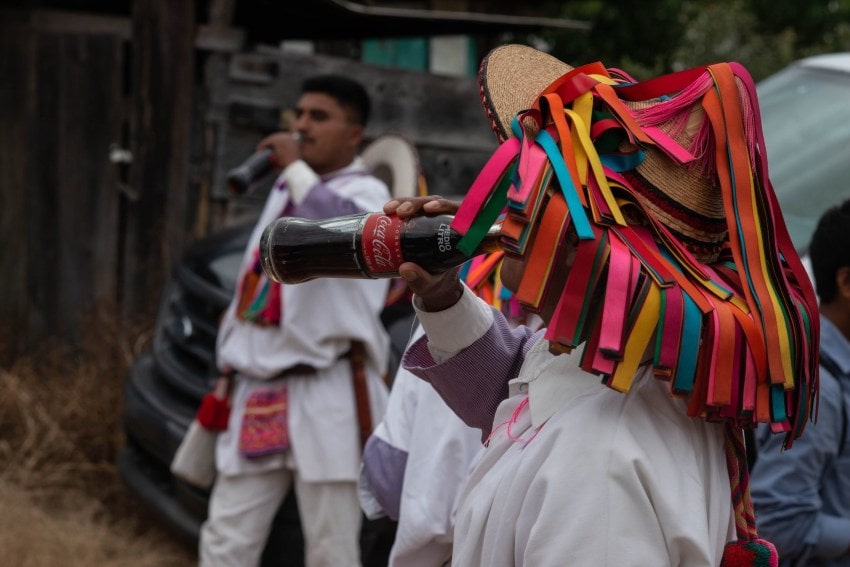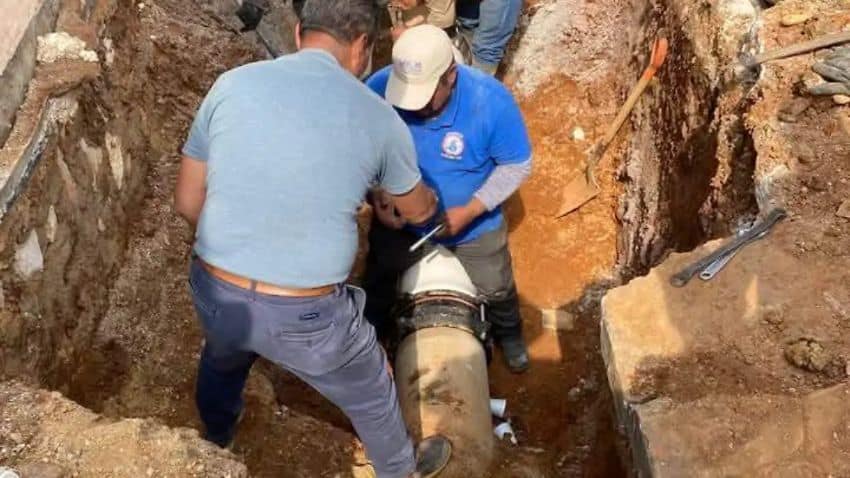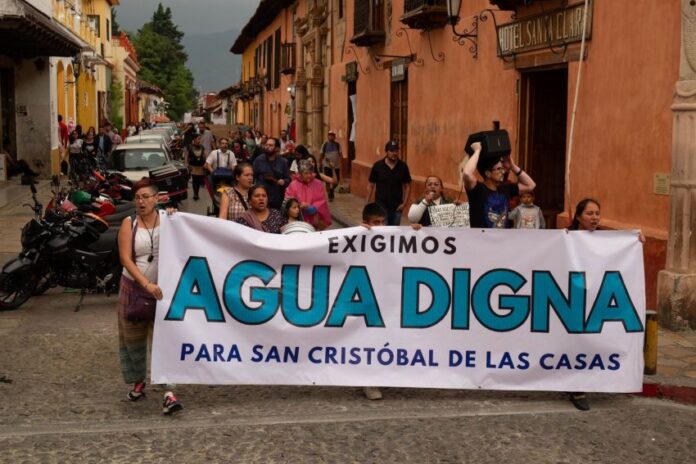“The Coke factory.”
That’s the answer almost anyone in San Cristóbal de Las Casas will give you if you ask why the fabled Pueblo Mágico nestled in the highlands of the southern state of Chiapas suffers from so many water shortages.

FEMSA, Coca-Cola’s Mexican subsidiary, has run a bottling plant on the outskirts of the city center since 1984.
“While in the barrios we don’t have water, Coca-Cola extracts 1.3 million litres of water a day,” reads one recent Facebook post, referring to a commonly cited statistic.
To be sure, Inmobiliaria del Golfo S.A. de C.V — FEMSA’s regional subsidiary — has government-issued concessions to extract up to 481,982 cubic meters of water a year, which equates to about 1.32 million liters per day.
On any given day, thousands of residents of the municipality will have no access to running water at all. Water supply through local pipes is regularly cut across various parts of San Cristóbal. Some parts of the city have been without a functioning water supply for years.
Such clear inequality has made FEMSA the target of various campaigns to rein in its water use, if not to have it pack up and leave San Cristóbal altogether. A petition to cancel the concessions, led by local activist group Otros Mundos Chiapas, has garnered over 24,000 signatures, and the water crisis in Chiapas is the subject of many international media stories.
Despite their compelling case, those seeking to restrict or cancel the presence of Coca-Cola in San Cristóbal also reckon with the reality that the bottling plant and its product is a fixture of life in this region. FEMSA says it provides “1,600 direct jobs and about 15 thousand indirect jobs” in Chiapas and invests in the community by funding reforestation efforts, water recapture and environmental education.

The population has returned the favor many times over. According to a 2019 National Autonomous University of Mexico (UNAM) study, Coca-Cola is consumed in Chiapas at a rate of 683.8 liters per person per year — more than anywhere else in the world. The Indigenous Tzotzil Maya of San Juan Chamula, a neighbouring town to San Cristóbal, even consider Coca-Cola to be a sacred beverage and consume it as part of religious ceremonies. Marketing campaigns by Coca-Cola have targeted the Maya, who are among Mexico’s poorest communities, by emphasising its accessible prices.
Activists have also called attention to the various health problems associated with the overconsumption of the beverage in Chiapas and for its contribution to plastic pollution in the region. Paste-ups showing scenes like babies being fed Coca-Cola in bottles held to their mouths by the Grim Reaper are a common sight on the walls of streets in the center of San Cristóbal, along with exhortations to drink traditional beverages like pozol and pulque instead of Coca-Cola and other soft drinks.
The UNAM study links a high rate of diabetes among Maya people in the Chiapas highlands to the substitution of “high-calorie drinks in the place of water,” specifically Coca-Cola and beer. In the absence of sufficient water, and with bottled water sold at a similar price as the soft drink, Coca-Cola consumption has soared.
Contamination and broken systems
Then there’s the dire state of the water itself. Like many other places in Mexico, the liquid that comes out of the taps in homes and local businesses within the municipality of San Cristóbal de Las Casas is not safe for human consumption. Indeed, the water is not treated for sewage, meaning it contains pathogens from human feces and causes high rates of illness in the population, with gastrointestinal disease a leading cause of death in rural Chiapas.
“This is our most severe problem — that we don’t treat the sewage,” says Rodrigo Hess Poo, an engineer who is coordinator of the Committee for Water in the Jovel Valley (CCVJ), whose name refers to the Tzotzil name for the valley where San Cristóbal de las Casas sits. The Committee is dedicated to providing acute solutions to the problems of water distribution and quality in San Cristóbal.
Untreated water causes the citizens of San Cristóbal thousands of pesos a year in health costs, confirms Hess. He explains that five distinct systems supply water to households and businesses for a fee. The most prominent, the Municipal System for Potable Water and Sewage (SAPAM) — is run by the municipality of San Cristóbal de las Casas and has been accused of corruption.
Moreover, says Hess, “The infrastructure is old and poorly maintained.” One of the committee’s key activities is to repair leaks and recover leaked water.
Breakdowns in governance are also blamed for shortages and cuts to water supply. A resident of La Hormiga, on the northern periphery of San Cristóbal, said they have not had running water in months because potentially responsible parties were fighting and “could not agree.”
In the central neighborhood of Cuxtitali, disputes between different entities have prohibited access to water for some years, a resident told Mexico News Daily.

The same resident said they believed there are many tomas clandestinas — unauthorized diversion of water for private use — which also contributes to water shortages.
Local solutions against a complex problem
It’s important to acknowledge the many elements of the city’s water problem, says Marcelino Turati, a director of Tu Bosque, an NGO in San Cristóbal that is dedicated to reforestation.
Industry overextraction also extends into the hospitality and mining industries, he notes.
Meanwhile, for Turati, reforestation is an obvious solution to the need for more water: “If we plant more trees, we’ll have more rain. By having more rain, we’ll have more surface water, and the springs will regenerate.”
As well as fixing leaks, the Committee for Water in the Jovel Valley distributes ceramic water filters to households so they can filter their tap water for drinking, and they conduct door-to-door outreach to inquire about water access and quality and promote their water-filtering solution.
Marcelino Turati and the Chiapas nonprofit Tu Bosque point out that San Cristóbal’s water shortages are also compounding an increasing problem with forest fires.
For the NGO Cántaro Azul, community participation is key to creating lasting, plentiful access to clean water as a human right for all. The organization has been supporting Indigenous communities to participate in the national consultation process for a new water law, as well as advocating for a more inclusive process.
The consultation process to date has been barely accessible to San Cristóbal’s Maya communities, says José Luis Méndez Rodríguez, a Tzotzil man who works as a coordinator at Cántaro Azul.
In order to ensure Maya communities are informed and their voices are heard, says Méndez, Cántaro Azul has spearheaded the new Chiapas Water Defense Network (RDAC), made up of representatives from the Indigenous communal authorities responsible for water and sanitation in the communities that surround San Cristóbal de Las Casas, including his home municipality of Sitalá, which lies north of the city.
In this way, Cántaro Azul hopes to broker the views of Maya communities on their own terms and promote the solutions that many are already implementing.
A call for corporate responsibility
As far as Coca-Cola is concerned, Marcelino Turati of Tu Bosque says a solution he’d like to see FEMSA get behind is swapping out plastic for glass bottles.
“It would be no problem for them to produce glass bottles, and it would be much more beneficial to the environment.”
Further, Coca-Cola could get on board with the treaty on single-use plastics, says Turati.
“They’re a part of the problem by their products polluting the rivers, so to address this they could support a tax on single-use plastics; this would be very achievable,” he says.
The company is also in a position to finance huge-scale projects in the region so that there is always rainwater, he adds.
“If I were them, I would even pay for the whole sewerage system of the city. They have the money. The company should be willing to invest in the solution.”
Ann Louise Deslandes is an independent journalist and consultant in San Cristóbal de las Casas.
